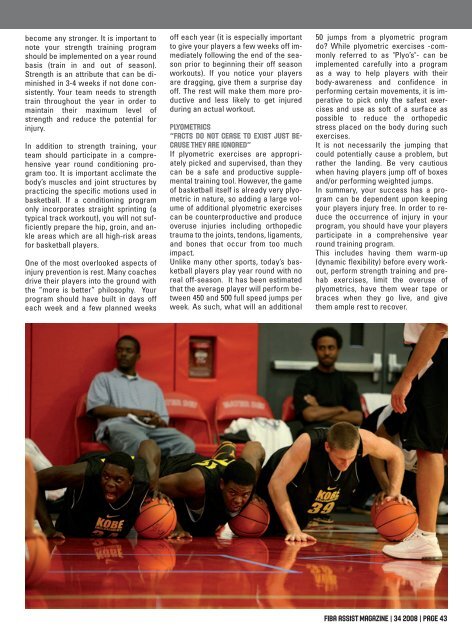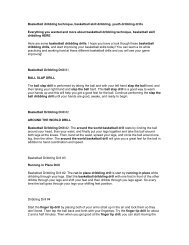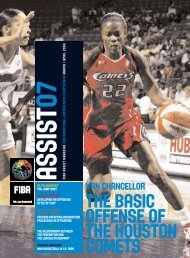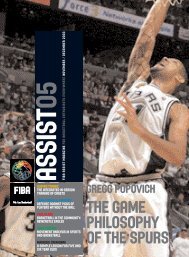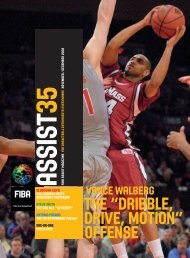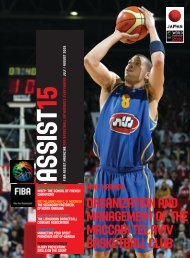“SLICE” AND “POINT” SETS - FIBA.com
“SLICE” AND “POINT” SETS - FIBA.com
“SLICE” AND “POINT” SETS - FIBA.com
Create successful ePaper yourself
Turn your PDF publications into a flip-book with our unique Google optimized e-Paper software.
e<strong>com</strong>e any stronger. It is important to<br />
note your strength training program<br />
should be implemented on a year round<br />
basis (train in and out of season).<br />
Strength is an attribute that can be diminished<br />
in 3-4 weeks if not done consistently.<br />
Your team needs to strength<br />
train throughout the year in order to<br />
maintain their maximum level of<br />
strength and reduce the potential for<br />
injury.<br />
In addition to strength training, your<br />
team should participate in a <strong>com</strong>prehensive<br />
year round conditioning program<br />
too. It is important acclimate the<br />
body’s muscles and joint structures by<br />
practicing the specific motions used in<br />
basketball. If a conditioning program<br />
only incorporates straight sprinting (a<br />
typical track workout), you will not sufficiently<br />
prepare the hip, groin, and ankle<br />
areas which are all high-risk areas<br />
for basketball players.<br />
One of the most overlooked aspects of<br />
injury prevention is rest. Many coaches<br />
drive their players into the ground with<br />
the “more is better” philosophy. Your<br />
program should have built in days off<br />
each week and a few planned weeks<br />
off each year (it is especially important<br />
to give your players a few weeks off immediately<br />
following the end of the season<br />
prior to beginning their off season<br />
workouts). If you notice your players<br />
are dragging, give them a surprise day<br />
off. The rest will make them more productive<br />
and less likely to get injured<br />
during an actual workout.<br />
PLYOMETRICS<br />
“FACTS DO NOT CEASE TO EXIST JUST BE-<br />
CAUSE THEY ARE IGNORED”<br />
If plyometric exercises are appropriately<br />
picked and supervised, than they<br />
can be a safe and productive supplemental<br />
training tool. However, the game<br />
of basketball itself is already very plyometric<br />
in nature, so adding a large volume<br />
of additional plyometric exercises<br />
can be counterproductive and produce<br />
overuse injuries including orthopedic<br />
trauma to the joints, tendons, ligaments,<br />
and bones that occur from too much<br />
impact.<br />
Unlike many other sports, today’s basketball<br />
players play year round with no<br />
real off-season. It has been estimated<br />
that the average player will perform between<br />
450 and 500 full speed jumps per<br />
week. As such, what will an additional<br />
50 jumps from a plyometric program<br />
do? While plyometric exercises -<strong>com</strong>monly<br />
referred to as "Plyo’s"- can be<br />
implemented carefully into a program<br />
as a way to help players with their<br />
body-awareness and confidence in<br />
performing certain movements, it is imperative<br />
to pick only the safest exercises<br />
and use as soft of a surface as<br />
possible to reduce the orthopedic<br />
stress placed on the body during such<br />
exercises.<br />
It is not necessarily the jumping that<br />
could potentially cause a problem, but<br />
rather the landing. Be very cautious<br />
when having players jump off of boxes<br />
and/or performing weighted jumps.<br />
In summary, your success has a program<br />
can be dependent upon keeping<br />
your players injury free. In order to reduce<br />
the occurrence of injury in your<br />
program, you should have your players<br />
participate in a <strong>com</strong>prehensive year<br />
round training program.<br />
This includes having them warm-up<br />
(dynamic flexibility) before every workout,<br />
perform strength training and prehab<br />
exercises, limit the overuse of<br />
plyometrics, have them wear tape or<br />
braces when they go live, and give<br />
them ample rest to recover.<br />
Fiba Assist Magazine | 34 2008 | Page 43


